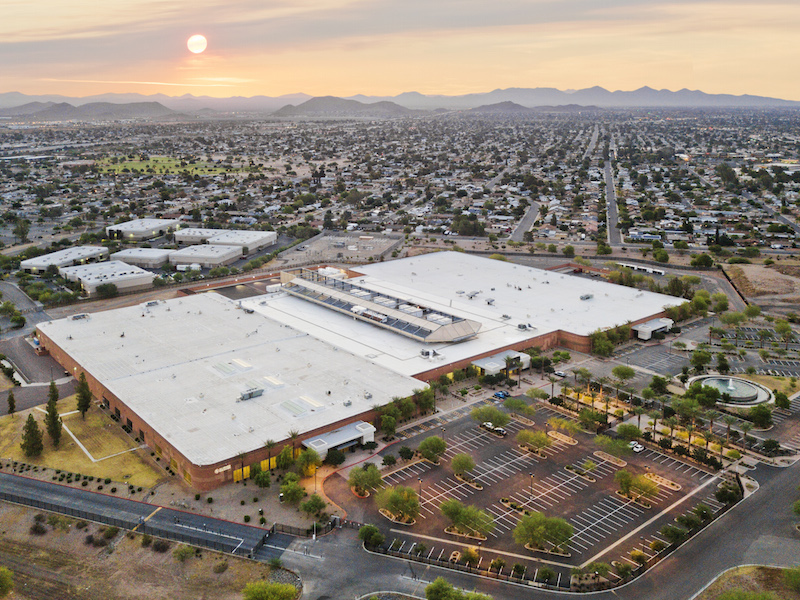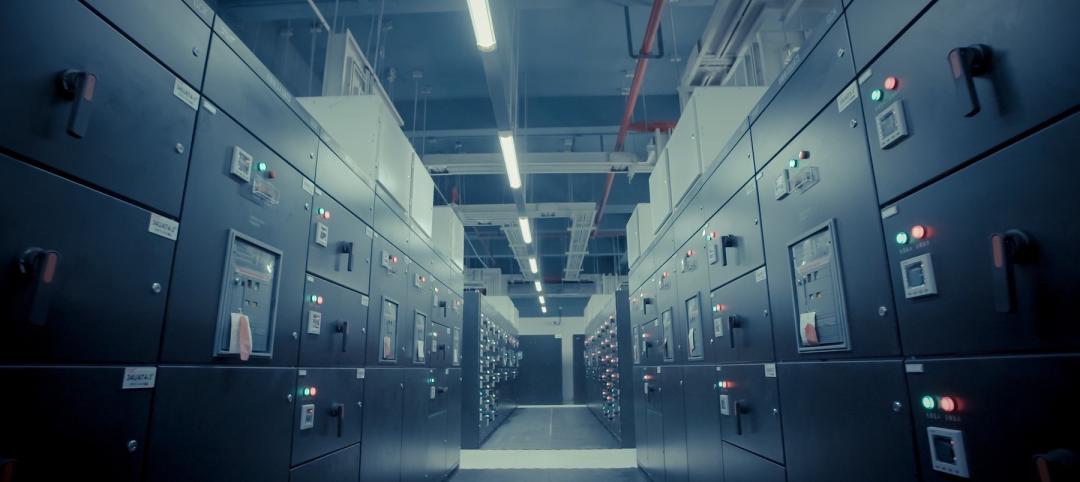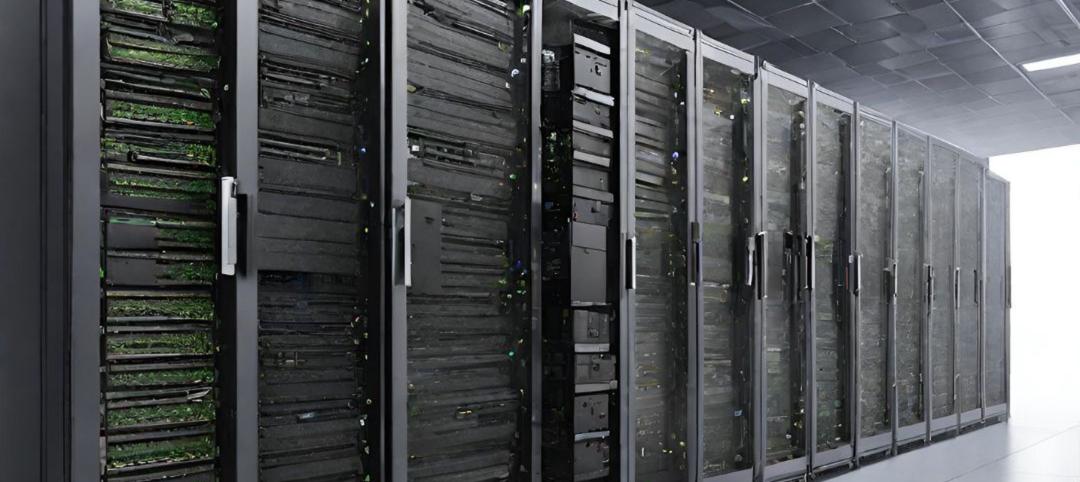Data centers are projected to consume 73 billion kilowatt hours of electricity by 2020. That would be 3 billion kWhs more than in 2014, according to the website Data Center Knowledge.
Providers are already scrambling to meet that anticipated demand. Through the first half of 2017 there were 506 MWs under construction, compared to the 353 MWs under construction during the same period a year earlier, according to JLL’s latest report on North America’s data center sector.
Large pipeline increases in Northern Virginia (plus 57 MW), Toronto (41 MW) and Dallas-Fort Worth (31 MW) “depict booming markets looking to catch up with demand,” JLL states.
The cloud is accounting for 30% or more of the demand in 11 of the 18 markets that JLL analyzed for its report. In fact, last year the predominate absorption driver in the data center sector was cloud focused. Microsoft Azure, Amazon Web Services (AWS), Oracle, SoftLayer, Google, and others captured huge portions of space, leading to one of the most robust leasing years on record.
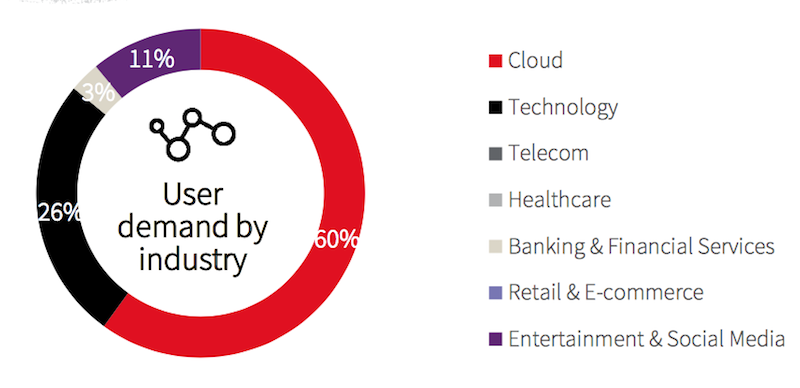
The cloud accounts for three-fifths of demand in Northern Virginia, one of hottest data center markets in the country. Image: JLL
Earlier this month, Bisnow and the Wall Street Journal reported that in their battle for the $500 billion database technology business, tech giants Google, Amazon, and Microsoft—which spent a combined $31.5 billion on data centers in 2016, up 22% from the previous year—are expanding their cloud infrastructures so rapidly that they are leasing data center space because they can’t build their own quickly enough.
2016 racked up over 350 MW of absorption in the U.S. and 46 MW in Canada. U.S. absorption rates cooled a bit in the first half of 2017, but JLL sees that leveling off as cloud users taking a temporary respite on leasing to work through the “massive” capacity they took on last year.
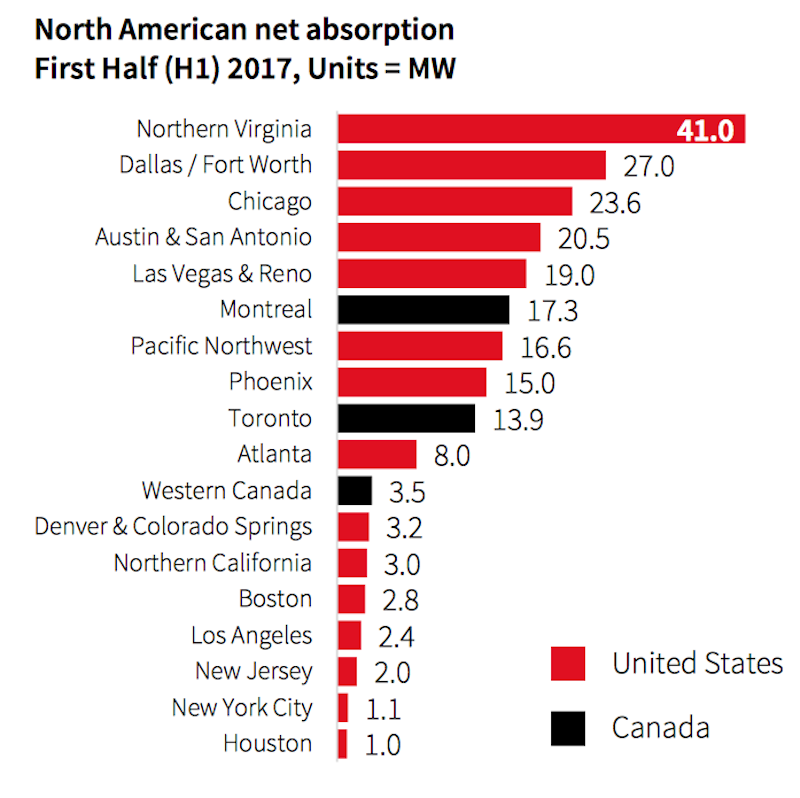
The predominate driver of absorption is cloud focused, according to JLL's latest report on the North America data center market. Image: JLL
Pent up data center demand from Fortune 1000 companies and enterprise users that previously were unable to grab capacity, due to low availability, are expected to lease up moderate to large chunks, and drive additional absorption through the year.
“Technology has changed where we are today,” says Michael Silla, Senior VP of Skanska USA’s Mission Critical Center of Excellence in Charlotte, N.C. “Technology is all about convenience—eBay, Amazon, Uber—driven by smartphones. And there are several cloud players, all driving hyperscale computing. We don’t know where the future is going, but we’re going to need computing to make it all work.”
In a recent interview with BD+C, Silla asserted that the future of data centers would revolve around infrastructure and “building what matters.” Skanska, he said, is positioning itself to become more of a partner with its data center clients, and to get involved in collaborative programming early in the process.
“We need to transfer from being a builder to being a trusted advisor” to help clients scale their facilities appropriately, Silla said.
Skanska is moving in this direction at a time of aggressive consolidation within the data center sector. JLL estimates there were nearly $2 billion in merger-and-acquisition deals among providers in 2016. Through the first six months of 2017, M&A activity jumped to over $10 billion, as the industry gravitates toward larger, more efficient facilities that offer comprehensive and flexible products to users looking for consistent global vendors.

As user demand expands, AEC firms will need to beef up their mission critical teams to keep pace. Image: Connie Zhou Photography
JLL expects M&A activity to continue through the remainder of this year and beyond. At the same time, Silla expects new providers to come onto the market. “Disruption is moving at such a pace that data center construction might not be able to keep up.”
The big challenge for companies like Skanska, he explained, is that AEC firms don’t have enough designers and builders to handle the current rate of data center growth. Skanska has taken its technical builders from other sectors and transferred them to data center design and construction.
“As an industry, we have to attract more talent,” he said, noting that several chapters of 7x24 Exchange International are now reaching out to colleges and universities.
A data center typically takes between six and eight months to build. But the industry’s volatility makes such scheduling less predictable. Skanska recently was finishing up a 5 MW data center in Phoenix when that facility signed a new customer with different requirements for its leased space. Keeping up with such changes, said Silla, is going to require better and more frequent coordination with data center developers and retailers.
In general, Silla thought that planning is “the key” to bringing a data center online on schedule and within budget. One positive change he’s seen is that designs have become more modular and scalable, and are factoring in load predictabilities and infrastructure needs more flexibly. Modularity, he suggested, might even extend a facility’s life cycle beyond its normal 12-to-15 year span.
AEC firms that serve this sector must also take into account what JLL singles out as the growing demand among users for data security and artificial intelligence, and how those needs are going to affect their businesses going forward.
Related Stories
Data Centers | Oct 1, 2024
10 biggest impacts to the data center market in 2024–2025
While AI sends the data center market into the stratosphere, the sector’s accelerated growth remains impacted by speed-to-market demands, supply chain issues, and design innovation necessities.
Data Centers | Sep 2, 2024
Data center demand continues its feverish growth rate
But JLL’s latest market report worries that the sector is outpacing its manpower and electricity capacities.
Multifamily Housing | Aug 21, 2024
Nation's leading multifamily developer expands into infrastructure
Greystar's strategy for infrastructure is driven by the shifting landscape of today's cities—primarily in the increased digitization, urbanization, and transitions to clean energy.
Data Centers | Aug 8, 2024
Global edge data center market to cross $300 billion by 2026, says JLL
Technological megatrends, including IoT and generative AI, will require computing power to be closer to data generation and consumption, fueling growth of edge IT infrastructure, according to a new JLL report.
Construction Costs | Jul 18, 2024
Data center construction costs for 2024
Gordian’s data features more than 100 building models, including computer data centers. These localized models allow architects, engineers, and other preconstruction professionals to quickly and accurately create conceptual estimates for future builds. This table shows a five-year view of costs per square foot for one-story computer data centers.
Data Centers | Feb 28, 2024
What’s next for data center design in 2024
Nuclear power, direct-to-chip liquid cooling, and data centers as learning destinations are among the emerging design trends in the data center sector, according to Scott Hays, Sector Leader, Sustainable Design, with HED.
Data Centers | Feb 1, 2024
Gen AI will drive data center growth, says latest JLL sector report
Power access is pushing developers toward alternative sources and secondary markets.
Data Centers | Nov 22, 2023
How is artificial intelligence impacting data center design?
As AI is reshaping how we interact with machines and the world around us, the design of data centers needs to adapt to this fast-changing landscape. So, Page pairs expert thinking with high-performing solutions to meet the needs of rapidly advancing technologies.
Data Centers | Nov 13, 2023
Data center sector trends for 2023-2024
Demand for more data centers is soaring, but delivery can be stymied by supply delays, manpower shortages, and NIMBYism.
Giants 400 | Oct 2, 2023
Top 50 Data Center Construction Firms for 2023
Turner Construction, Holder Construction, HITT Contracting, DPR Construction, and Fortis Construction top BD+C's ranking of the nation's largest data center sector contractors and construction management firms for 2023, as reported in Building Design+Construction's 2023 Giants 400 Report.


